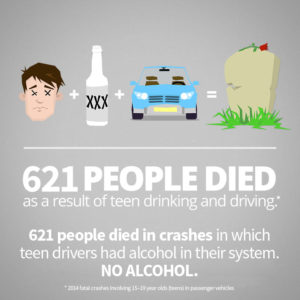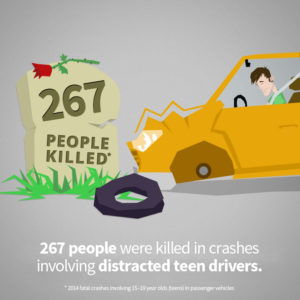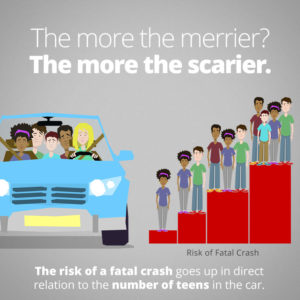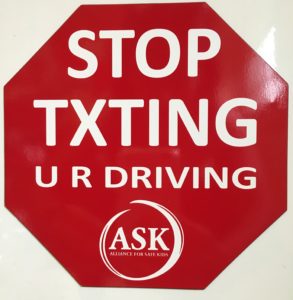The Alliance for Safe Kids (ASK) is joining with the National Highway Traffic Safety Administration (NHTSA) during National Teen Driver Safety Week (October 16-22) to promote the “5 to Drive” campaign to encourage all parents to talk to their teen drivers about the rules of the road when they are behind the wheel.
“Parents have a very strong influence on their teens, even as they grow older and become more independent,” said Liz Talbert, Coalition Coordinator at ASK. “The ‘5 to Drive’ campaign offers parents and caregivers some tips and a framework to talk to their teen drivers about dangerous driving behaviors that can end with fatal consequences.”
Motor vehicle crashes are the leading cause of death in teens, ahead of all other types of injury, disease or violence. In 2014, 2,679 teen (15-19 years old) passenger vehicle drivers were involved in fatal traffic crashes, resulting in 3,004 deaths nationally. An estimated 123,000 teen passenger vehicle drivers were injured in motor vehicle traffic crashes.
Parents can play an important role in helping ensure their teen drivers take smart steps to stay safe on the road. The “5 to Drive” campaign gives parents tips on how to talk about safe driving behaviors with their teens and address the five most dangerous and deadly driving behaviors for teen drivers: alcohol, lack of seat belt use, distracted driving, speeding, and extra passengers.
NHTSA’s website, www.safercar.gov/parents, has detailed information and statistics on teen driving and five basic rules parents can use to help save the lives of teen drivers:
 No Drinking and Driving. All teens are too young to legally buy or possess alcohol, but they are still at risk.
No Drinking and Driving. All teens are too young to legally buy or possess alcohol, but they are still at risk.
Nationally in 2014, one out of five teen passenger vehicle drivers (15 to 19 years old) involved in fatal crashes had been drinking. Remind your teen that driving under the influence of any impairing substance, including illicit or prescription drugs, could have deadly consequences.- Buckle Up. Every Trip, Every Time, Everyone—Front Seat and Back. Wearing a seat belt is one of the simplest ways for teens to stay safe in a vehicle. Yet, too many teens are not buckling up and neither are their passengers. In 2014, there were 763 passengers killed in passenger vehicles driven by teen (15-19 years old) drivers, and 59 percent of those passengers who died were NOT buckled up at the time of the fatal crash. When the teen driver was also unrestrained, the percentage of those passengers who were not restrained jumped to almost 86 percent. Remind your teen that it’s important for everyone to buckle up on every trip, every time, no matter what.
 Eyes on the Road, Hands on the Wheel. All the Time. – Distractions while driving are more than just risky—they can be deadly. In 2014, among teen passenger vehicle drivers (15-19 years old) involved in fatal crashes, 10 percent were reported as distracted at the time of the crash. Remind your teen about the dangers of texting, dialing, or using mobile apps while driving. But distracted driving isn’t limited to cell phone use. Other passengers, audio and climate controls in the vehicle, and eating or drinking while driving, are all examples of dangerous distractions for teen drivers.
Eyes on the Road, Hands on the Wheel. All the Time. – Distractions while driving are more than just risky—they can be deadly. In 2014, among teen passenger vehicle drivers (15-19 years old) involved in fatal crashes, 10 percent were reported as distracted at the time of the crash. Remind your teen about the dangers of texting, dialing, or using mobile apps while driving. But distracted driving isn’t limited to cell phone use. Other passengers, audio and climate controls in the vehicle, and eating or drinking while driving, are all examples of dangerous distractions for teen drivers.- Stop Speeding Before It Stops You. Speeding is a critical issue for all drivers, especially teens. In 2014, almost one-third (30%) of teen passenger vehicle drivers involved in a fatal crash were speeding at the time of the crash. Remind your teen to drive within the speed limit.

- No More Than One Passenger at a Time. Extra passengers in a teen’s car can lead to disastrous results. According to data analyzed by NHTSA, teen drivers were two-and-a-half times more likely to engage in one or more potentially risky behaviors when driving with one teenage peer compared to when driving alone. And the likelihood of teen drivers engaging in risky behaviors triples when traveling with multiple passengers.
Parents can help protect their teen drivers by talking with them about these risks. Surveys show that teens whose parents set firm rules for driving typically engage in less risky driving behaviors and are involved in fewer crashes.
 Explaining the rules and any other restrictions outlined in New York’s graduated driver licensing (GDL) law and the deadly consequences of unsafe driving practices can help encourage teens to exhibit safe driving behaviors. The “5 to Drive” campaign helps parents start the conversation.
Explaining the rules and any other restrictions outlined in New York’s graduated driver licensing (GDL) law and the deadly consequences of unsafe driving practices can help encourage teens to exhibit safe driving behaviors. The “5 to Drive” campaign helps parents start the conversation.
“Laws are not enough to protect these young drivers. We need parents to set the rules before their teens hit the road,” Talbert said. “We hope parents will start the conversation about the ‘5 to Drive’ campaign during Teen Driver Safety Week – but then continue the conversations—every day throughout the year—to help keep their teens safe behind the wheel.”
Interested in helping us spread the word? Consider making a donation of $25 or more and receive a “Stop Txting. U R Driving” car magnet!
For more information about Teen Driver Safety Week and the “5 to Drive” campaign, please visit www.safercar.gov/parents.
